In our last several posts we have examined the avenue, attendees, and accounts of the Hampton Court conference. In a future post we will zoom in on the request made at the conference for a new translation which resulted in our King James Bible. To place that request in historical and political context, a clear overview of the events of the entire conference is first needed. To that end, this post and the next two will each overview one day of the conference.
The Activities – Historical Difficulties
Patrick Collinson, that veteran scholar of Puritanism, cautions that “the historian of Hampton Court faces formidable difficulties” (pg. 36 here). I have repeatedly found his dictum true while sifting through partial and contradictory accounts. Revisionist interpretations of Hampton Court and the larger political and religious currents it symbolized bequeath fresh difficulties to a modern historian. Collinson earlier cautioned that “the Hampton Court conference and its outcome are not to be over-simplified, still less to be over-dramatized” (pg. 459 here). At the risk of over-simplifying, can the events of the conference be briefly summarized? This and the next two posts make a humble attempt.
The Pre-Conference Meeting – Thursday, 12 January 1604
On Thursday morning, archbishop John Whitgift, with bishops Richard Bancroft of London, Toby Matthew of Durham (made archbishop of York two years later), Thomas Bilson of Winchester, Gervase Babington of Worcester, Anthony Rudd of St. David’s, Anthony Watson of Chichester, and Henry Robinson of Carlisle all gathered in the king’s Privy Chamber for the start of the conference. As we have noted before, the date had been mistaken. They did not yet know this with certainty (though it is possible they had heard rumors) so they gathered and waited.
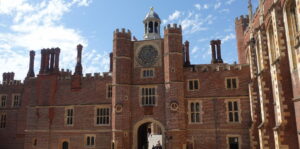
The Astronomical Clock as viewed from the rooms in which the Hampton Court Conference was held. Photo Credit – Hannah Berg
They were eventually called by the king into his private Withdrawing Chamber. Matthew might have glanced out the window, across the court at the great astronomical clock, or simply heard its chime. In any case, he noted that it was 9:00 am when they were called out of the Privy Chamber. The king explained that the day had been mistaken but also gave the bishops an explanation of what the conference would entail.
Patrick Galloway, the Scotsman who had accompanied James to England, explained that the bishops were asked “to advise upon all the corruptions of this church, in doctrines, ceremonies, and discipline; and as they will answer to God in conscience, and to his majesty upon obedience, that they should return the third day after, which was Saturday.” He clocked the meeting at five hours and mistakenly counted it as the first day of the conference. Bishop Matthew recounted that they were brought into the king’s private inner Withdrawing Chamber:
Where, in a very private manner, and in as few words, but with most gracious countenance, he [the king] imparted to us, first, the cause wherefore we were called up; which was, for the reformation of some things amiss in ecclesiastical matters, supposed, and by some complained of….Lastly, his majesty gave us to understand, that the day was somewhat mistaken, being meant by him to be the Saturday after; at which time his majesty willed us to repair at the court again.
The significance of this intimate “pre-conference meeting” should not be underestimated. The bishops were given personal and private audience with the king in the most secretive and protected part of his palace (apart from his Privy Lodgings, where he never entertained visitors). When the conference proper started Saturday, the bishops already knew the king’s agenda. They had, in a way, foreseen the direction of the conference before it began.
Day One – Saturday, 14 January 1604
On Saturday the Privy Council, deans, and doctors made their way through the Great Hall to the great Watching Chamber and through the small doorway in the corner of the room into the King’s Presence Chamber. They found the four Puritan speakers already there, “sitting upon a form” or inelegant wooden bench (Barlow pg. 2), apparently unaware that the plans for the conference had changed and that they would not be part of this day’s proceedings. The king called the bishops at 11:00 am into his personal Privy Chamber.
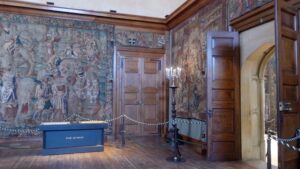
The Great Hall (through the doors to the right) leads into the Watching Chamber (where the photographer is standing). From the Watching Chamber, through the small doors pictured on the left (now closed to the public), one would enter the king’s Presence Chamber. Photo Credit – Hannah Berg
The Puritans were left in the Presence Chamber, separate from the proceedings entirely. At the end of the day, the Lord Chancellor called for them to inform them to return Monday. Disappointment must have crossed their faces as they were shuffled around and then summarily dismissed, never even reaching the Privy Chamber, the king’s inner sanctum.
The bishops, on the other hand, went straight into the Privy Chamber. While waiting, commandment came from the king that only the Privy Council, the Bishops, and five of the deans (Royal Chapel, Westminster, Paul’s, Chester/Westchester, Salisbury) were allowed in. When they were all called in, the Lord Chamberlain shut the door. The king entered from his Privy Lodgings and his special chair was pulled out for him from beneath the canopy of state and placed in the center of the room (Thurley pg. 108). The Privy Council was seated on his right, the bishops on his left. James entered and sat.
The conference began.
James opened with an hour-long speech. He explained that, contrary to a century of English monarchs for whom change seemed the only constant, he saw no reason to “alter and change anything,” choosing rather “to confirm that which he found well settled already.” He thanked God “for bringing him into the promised land, where Religion was purely professed,” a place much preferable to Scotland, where his authority had been so often challenged by “beardless boys” who would dare to “brave him to his face” (Barlow pg. 4-5). He assured the bishops that “he called not this assembly for any innovation,” acknowledging the status quo “to have been approved by manifold blessings from God himself,” for the growth of both the gospel and “a most happy and glorious peace.” He intended no sweeping changes for the church (despite radical Puritan hopes). James would maintain the Elizabethan settlement with only slight tweaking, like a physician making small adjustments to a minor ailment – if indeed ailment could be found. He determined to “give factious spirits no occasion” for glory, Barlow explained. That was why he had called the bishops in “severally by themselves, not to be confronted by the contrary opponents,” so that if anything was discovered that really did need addressed, “it might be done without any visible alteration”(Barlow pg. 6), a point James repeated several times.
James set out his own agenda for the conference and what he expected from the bishops under three heads (Barlow pg. 6-7):
- Issues with the Book of Common Prayer
- Confirmation
- The general absolution
- Private baptism by lay persons
- Excommunication and the ecclesiastical courts
- The matter
- The persons
- Provision of Protestant preachers for Catholic Ireland
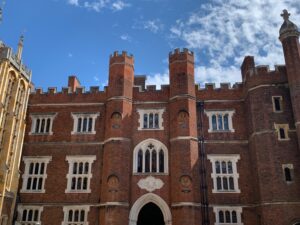
The rooms in which the Hampton Court conference was held, now completely remodeled, viewed from the Clock Court. Photo Credit – Hannah Berg
They took each of the king’s matters in turn. Archbishop John Whitgift replied first to each question as an official voice then opened the floor to the lower bishops. Discussion about private baptism was most significant, taking up three of the day’s five hours (Cardwell pg. 139). When lay baptism by women was raised, James explained that he would as soon have his child baptized by an ape as by a woman. Harley MS 828 records the bishops discussing legends of an ancient father baptizing with sand when water was unavailable. “A turd for the argument,” James responded: “he might as well have pissed on them, for that had been more like to water than sand” (Usher Vol. II pg. 342). When the Puritans raised this issue on day two, they were informed that it had already been decided. They were late to a fiery party that had all but concluded without them.
The time flew by because the king fielded all the points so masterfully, Barlow concluded. He lavished praise on the king and noted the biting irony that a king “brought up among Puritans” (meaning here the Scottish Presbyterians) and “schooled by them” should show himself as learned as the greatest scholars. Barlow could make sense of the irony because the king, though brought up under Puritans from the time he was ten, had always disliked their opinions. As was said of the Savior, “though he lived among them, he was not of them” (Barlow pg. 20).
James commissioned the bishops to continue discussing the remaining less important issues and come to final decisions before the final day of the conference. The second day (Monday) was “appointed…for the Opponents to bring in their Complaints;” the third and final day (Wednesday), “for the exhibiting of their [James’ and the bishops’] determinations in these points” (Barlow pg. 19). Chadderton took offense at this characterization of the Puritan spokesmen as being “appointed.” Arnold Hunt’s study of Chadderton’s copy of Barlow’s “Sum and Substance” which we discussed in our last post shows that he annotated at this point, “they knew no such appointment.” (Hunt pg. 212). In any case, Craig summarizes James’s role on this first day:
The first session of the conference at Hampton Court was without question the King’s conference, and he seems to have planned and conducted it with little thought to what points the [Puritan] ministers might bring before him on Monday. In the presence of the Privy Council the King presented a series of questions and concerns about his new church to the bishops, and either accepted or disputed their answers (Craig pg. 209).
The next day, Dudley Carleton wrote to John Chamberlain and summarized this first day. The bishops were actually being consulted by the king for advice, as opposed to the Puritans, whose complaints would merely be heard. The king’s sympathies were showing. Carleton also pointed out the visible distinction between the two parties even in their dress, emblems of respective conformity and non-conformity:
Yesterday the bishops with 4 or 5 of the deans were in Privy Chamber before the king and the lords of the council, to whom the king made a speech with great respect to them and their callings and told them he sent not for them as persons accused but as men of choice, by whom he sought to receive instruction and chiefly sought to be satisfied in the points of confirmation, absolution, excommunication, and private baptism….In conclusion the king seemed to be reasonably satisfied, only [he] did wish some alteration of scandalous words in the common prayer book, but the substance to remain, upon which he willed the bishops to advise and return to him again on Wednesday next. Meantime Patrick Galloway and his crew shall have their turn, and tomorrow they appear before the king. These two companies as they differ in opinions, so do they in fashions, for one side marches in gowns and rochets and the other in cloaks and nightcaps.
– Dudley Carleton to John Chamberlain, 15 January 1604, (Letter 21, pg. 53-60 here)
Many of the most important decisions of the conference were made here on this day, before the Puritan spokesmen even had a chance to bring their complaints, suggesting that their complaints matter less to the final decisions than sometimes thought. The game was rigged from the start. Still, on the second day, the spokesmen would “have their turn.” In our next post we will watch on as they finally get their audience with the king.
Posts On The Hampton Court Conference
- Hampton Court – Avenue And Dates
- Hampton Court – Attendees
- Hampton Court – Accounts
- Hampton Court – Activities Day 1
- Hampton Court – Activities Day 2
- Hampton Court – Activities Day 3
- Hampton Court – A New Bible
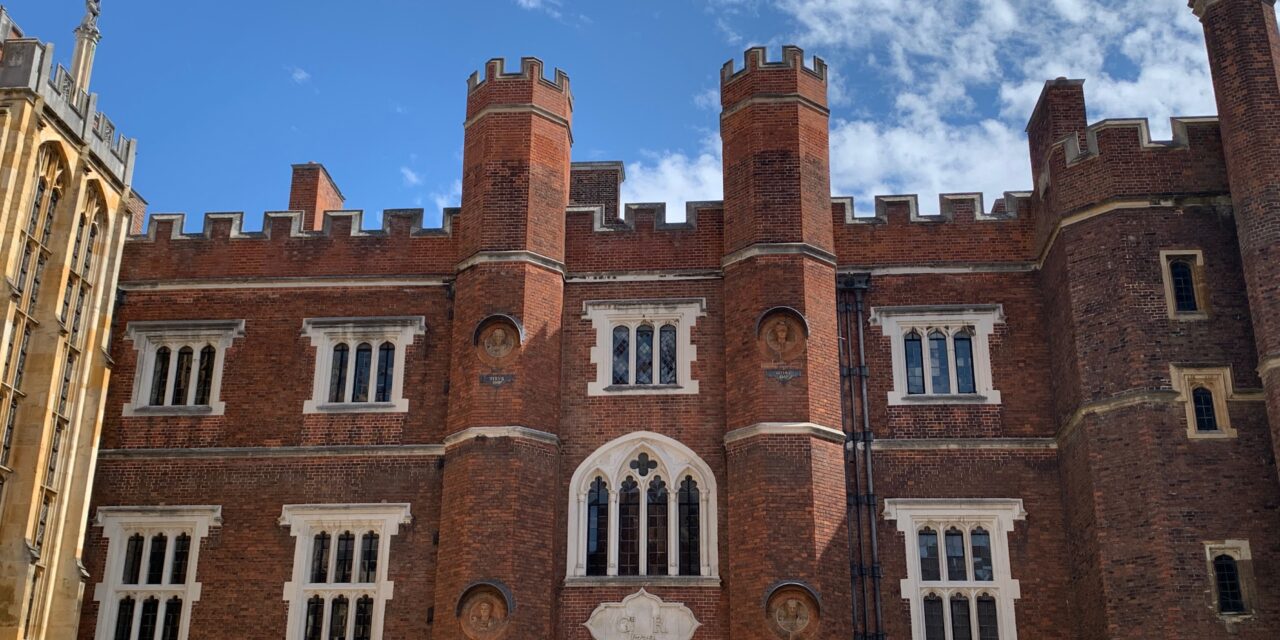
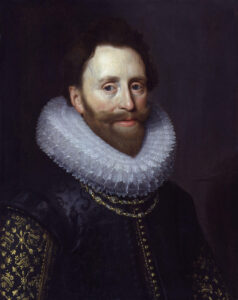
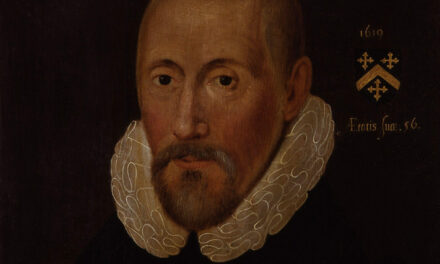

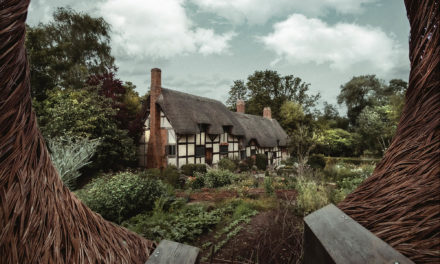

Comments